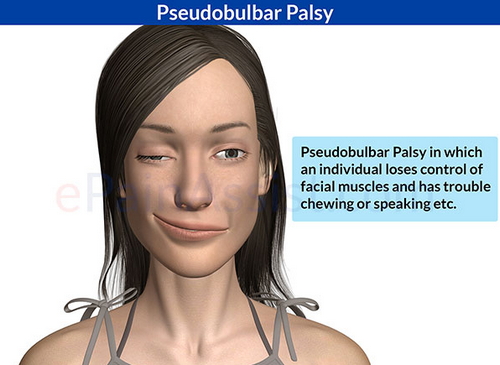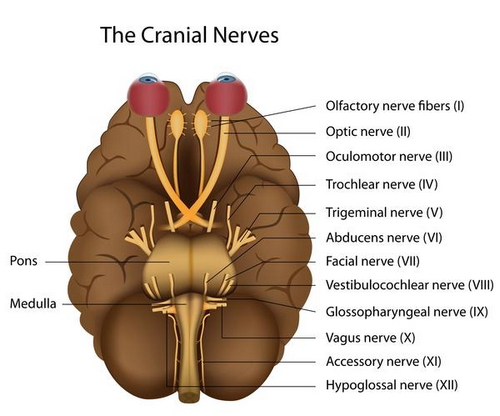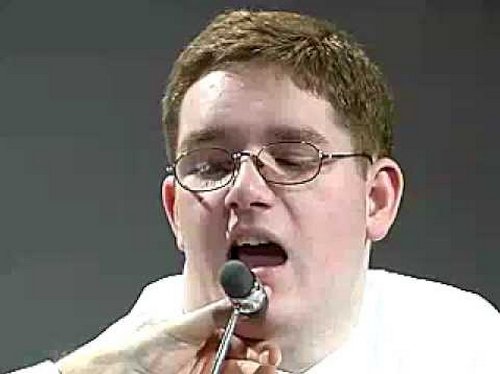Bulbar Palsy
Last reviewed by Dr. Raj MD on January 12th, 2022.
What is a bulbar palsy?
It is a pathological condition of the cranial nerves. At least five cranial nerves that control movement are affected (cranial nerves V, VII, IX, X, XI).
Each cranial nerve has a specific set of movements. It is a medical term used to describe muscle paralysis or weakness supplied by the medulla. The affected cranial nerves are the following:
- Cranial nerve V (trigeminal nerve) – chewing
- Cranial nerve IX and X – swallowing and esophageal motility
- Cranial nerve XI – It has something to do with the sternocleidomastoid and trapezius muscles (1, 2)

Image 1: A typical clinical manifestation of a patient with bulbar palsy.
Photo Source: www.epainassist.com

Picture 2: The cranial nerves from I to XII
Image Source: edc2.healthtap.com

Photo 3: A child diagnosed with pseudobulbar palsy – testing with jaw reflex (if exagerated then called pseudobulbar palsy as it is UMN lesion and in bulbar palsy not reflex as it is LMN lesion)
Picture Source: i.ytimg.com
Bulbar palsy vs pseudobulbar palsy
There are differences between bulbar palsy and pseudobulbar palsy. The former is a lower motor neuron lesion of the cranial nerves IX, X, XI, and XII while the latter is an upper motor neuron lesion affecting IX, X, XI, and XII cranial nerves.
Both primarily affects men 75 years old and above.
Those with pseudobulbar palsy lacks facial expression. There is also chewing difficulty. (2, 3, 4, 5)
Table : difference between bulbar and pseudobulbar palsy

Juvenile progressive bulbar palsy
It is also known as Fazio-Londe disease. This condition is limited to bulbar muscles. It has an early onset, which is typically one to five years of age. The initial clinical manifestations are dysphagia and facial weakness. (4)
Progressive bulbar palsy
It is an extremely rare type, which can manifest in childhood and adulthood. The initial symptoms are restricted to bulbar muscles. The patient will experience progressive dysarthria with gagging for several months. There is also speech disturbances, choking, and weight loss.
The clinical manifestations worsen over time. It primarily involves the brain stem, a part of the brain responsible for speaking, swallowing, chewing, and other basic functions.
The typical clinical manifestations of bulbar palsy are swallowing difficulty, the jaw appears weak, the tongue is weak, facial muscles appear weak, and there is a progressive loss of speech. It is a variant form of amyotrophic lateral sclerosis (ALS). (5, 6, 7)
Bulbar palsy Causes
There are various factors causing bulbar palsy. These include the following:
- Toxic chemicals causing paralysis (8)
- Malignant condition affecting the brain
- Inflammatory diseases such as Guillain-Barre syndrome
- Genetic link (7)
Bulbar palsy Symptoms
- Absent of gag reflex
- Absent of jaw jerk
- The speech appears to be nasal
- Has a nasal twang and lacks modulation
- Fasciculation of the limb
- Dysphagia (difficulty swallowing)
- Difficulty chewing foods
- The tongue appears small (8, 9)
Diagnosis
Diagnosing progressive bulbar palsy can be quite difficult. There is no specific test that provides a definitive diagnosis. The diagnosis is made based on the symptoms and assessment of the functions of the cranial nerves.
To identify the etiology of the disease, an MRI of the brain and CSF analysis are ordered. A neurologic exam is done to assess the neurologic functions of the patient. The doctor will also order blood tests to detect other possible causes of the patient’s condition. An EMG study can be performed too to check the body’s muscle activity and detect abnormalities (if there is any). (4, 7, 9, 10)
Bulbar palsy Treatment
There is no exact cure for bulbar palsy. What the doctors can do is to treat the underlying symptoms. The patient receives supportive management. The goal is to make the patient’s life easier and comfortable. The patient will be needing help in performing activities of daily living such as feeding and mobility.
Patient with a severe case of dysphagia needs to be put on a nasogastric tube (NGT) to aid in feeding. The patient should as well undergo a physical therapy so that the muscles will not be stiff.
Bulbar palsy affects the patient’s ability to speak. To help the patient speak better, a speech therapist is needed. The patient should also see a psychologist for counseling because the severity of the symptoms can surely affect the patient’s self-esteem. Bulbar palsy is disabling and there is a possibility that the patient will be depressed.
Medications are also important in the management of the patient’s symptoms. The doctor will order medications to treat muscle spasms, pain, and muscle weakness. If the patient gets severely depressed, he will be put on antidepressants. The treatment is based on the patient’s clinical manifestations. Again, there is no cure for bulbar palsy.
Healthcare professionals can only offer supportive care and management. Neuron degeneration cannot be reversed. (2, 5, 9, 10)
Progressive bulbar palsy life expectancy and prognosis
Bulbar palsy has a poor prognosis. The life expectancy is usually one to three years after diagnosis. The patient usually dies because of respiratory complications secondary to recurrent aspiration. (2, 4)
References:
- https://en.wikipedia.org/wiki/Bulbar_palsy
- https://lifeinthefastlane.com/resources/bulbar-and-pseudobulbar-palsy-ddx/
- https://www.epainassist.com/nerves/bulbar-palsy
- https://patient.info/doctor/bulbar-and-pseudobulbar-palsy
- https://rarediseases.info.nih.gov/diseases/10928/progressive-bulbar-palsy
- https://www.sciencedirect.com/topics/neuroscience/progressive-bulbar-palsy
- https://www.amboss.com/us/knowledge/Bulbar_palsy
- https://www.patientslikeme.com/conditions/2150-progressive-bulbar-palsy
- http://symptomscausestreatment.com/bulbar-palsy-symptoms-causes-treatment.html
- http://www.wikilectures.eu/w/Progressive_Bulbar_Palsy